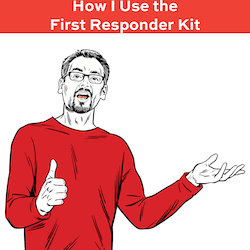How I Use the First Responder Kit
 You’ve downloaded sp_Blitz, sp_BlitzIndex, and sp_BlitzCache from the First Responder Kit, and you’ve run them a few times. You know there’s a ton of advice in there, but…it’s kinda overwhelming. Where should you even start? What should you tackle first? Are there parameters that would help diagnose your specific situation?
You’ve downloaded sp_Blitz, sp_BlitzIndex, and sp_BlitzCache from the First Responder Kit, and you’ve run them a few times. You know there’s a ton of advice in there, but…it’s kinda overwhelming. Where should you even start? What should you tackle first? Are there parameters that would help diagnose your specific situation?
In this one-day course, I’ll walk you through running them on your production server, and we’ll interpret your results together. Space is limited in these particular live classes because I’ll be giving you advice on your specific server.
Here’s how the day will go:
- You’ll run sp_Blitz to do a server-wide health check
- You’ll run sp_BlitzFirst to look at your server’s wait stats and storage throughput since it started up
- You’ll run sp_BlitzCache to find the queries causing your top wait types, using my favorite parameters for deeper diagnosis and trending
- You’ll run sp_BlitzIndex to diagnose the most urgent indexing issues specifically related to your top wait types
- You’ll see where sp_BlitzLock and sp_BlitzWho fit in
- You’ll write up a report to hand off to the rest of your team about what you learned about your server today, and what actions everyone needs to take in order to see a performance boost
Throughout the day, as you have questions about the data you’re seeing, you can post screenshots in the class’s Slack channel and get advice from me (and the rest of the students!) You’ll learn not just from your own questions, but also from the data that the other students are sharing about challenges they’re facing, too.
This course is 100% demos: the only slides are the introductions at the start of the day, and the recap at the end of the day. The rest of the time, we’ll be working in SQL Server Management Studio. Roll up your sleeves and join me!
What’s out of scope: I won’t be teaching you how to fix the problems on your server – that’s where our Fundamentals and Mastering classes come in. In this class, I’m focusing on how to use these scripts to write a good health and performance report. You won’t be handing me queries or tables to fix, but instead, I’m going to show you how to prove – with data, not feelings – where the problems are, and what you should focus on first.
Introductions
Your Progress So Far in This Class
This is driven by the mark-as-complete buttons in each module of the class. (Let’s be honest: you’re probably just going to mark them as complete because you’re that kind of student. I feel you.)
- 00 Prerequisites Before the Class
- 01 Doing a Server-Wide Health Check with sp_Blitz
- 02 Doing a Server-Wide Performance Check with sp_BlitzFirst
- 03 Using sp_BlitzCache to Find the Queries Causing Your Top Waits
- 04 Using sp_BlitzIndex to Diagnose the Most Urgent Index Issues
- 05 Analyzing Deadlocks with sp_BlitzLock
- 06 Check Which Queries Are Running with sp_BlitzWho and sp_WhoIsActive
- 07 Check Your Data Risks with sp_BlitzBackup
- 08 Automate the Data-Gathering Process with the Consultant Toolkit
- 09 Recap and Writing Up Your Findings
